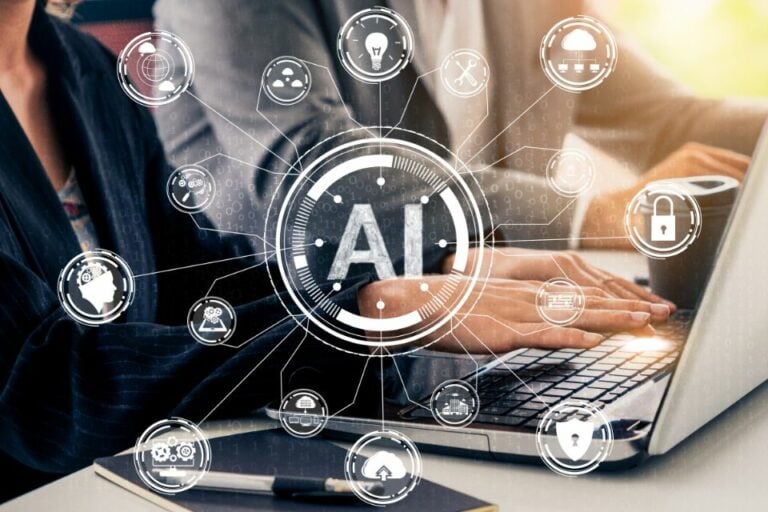7 Best AI Chatbots for Developers in 2025 (Boost Productivity)
Okay, let’s be real. “Chatbot for developers” might sound like something out of a sci-fi movie, but it’s actually one of the most practical and powerful ways to boost your coding game. Imagine having a smart assistant that can write code for you, debug your mistakes, and even find the right documentation in seconds.
That’s what AI-powered chatbots can do, and this guide is going to show you exactly how they work. We’ll be focusing on easy-to-understand explanations and practical examples, so you don’t need a PhD in artificial intelligence to get started. Think of it like this: you wouldn’t build a house without power tools, right? Chatbots are like power tools for coding.
If you’re curious about how AI is transforming industries, check out our guide on how ChatGPT is revolutionizing startup success.
Key Takeaways:
- Speed Up Coding: Generate code snippets quickly.
- Fix Bugs Fast: Rapidly identify and resolve errors.
- Navigate Documentation: Easily access API information.
- Learn New Languages: Get help with programming concepts.
- Automate Tasks: Streamline repetitive coding activities.
- Select Wisely: Choose tools based on needs and budget.
What Exactly Is a Chatbot for Developers? (Making It Simple)
So, what is it that we’re talking about when we say a chatbot for developers? Forget complicated jargon—it’s simply a type of software that uses natural language processing (or NLP) to understand what you’re saying, like a conversation, and then helps you with your coding.
These tools use machine learning (or ML), which is where they learn from large amounts of data to get better at what they do over time. You ask them a question in natural language (the way you normally talk), and they give you back the answers or the code you need.
For a deeper dive into how NLP works, read our article on prompt engineering and NLP.
The Key Differences: Chatbots vs. Virtual Assistants
You might be thinking, “Isn’t that like virtual assistants like Alexa or Siri?” Well, kind of, but not really. Virtual assistants are designed for everyday tasks (playing music, setting reminders). While chatbot developers create tools that are hyper-focused on helping you write code.
They do this by leveraging human language to improve developer productivity. Think of a chatbot as a specialized tool, while a virtual assistant is more of a general helper.
If you’re interested in exploring more AI tools, check out our comparison of Bard vs. GPT-4.
Why Would You Need a Chatbot as a Developer? (Highlighting the Benefits)
If you are an aspiring affiliate marketer, it’s key to understand why you need this type of software so that you can explain it to others and recommend the right tools. So, why use one?
- Speed Up Your Coding: Chatbots can generate code snippets faster than you can type them.
- Fix Bugs Faster: They can help you find and fix errors, saving hours of frustration.
- Make APIs Easy: No more spending hours reading through documentation!
- Learn New Languages Faster: You can use them to help you pick up new coding languages and frameworks.
- Boost Productivity: Basically, they automate away all the repetitive tasks so you can focus on the big picture.
For more tips on boosting productivity, check out our guide on long-term content strategy.
How Do Chatbots for Developers Actually Work? (Easy to Understand)
Okay, let’s peek under the hood, but without getting too technical. Here’s the simplified process:
- You Ask a Question: You type in plain English or a specific coding query in natural language. Think of it as a question in regular text to search for something.
- The Chatbot ‘Understands’: The chatbot uses natural language processing (NLP) and machine learning to understand your question.
- It Finds the Answer: The chatbot leverages code, API access, or even past queries to find an answer.
- It Gives You the Goods: It sends you the code snippet, explains a concept, or finds the correct documentation for you. This might involve API requests behind the scenes for documentation or integrations with platforms to make things seamless.
Types of Chatbots for Developers: Picking the Right Tool (Comparison)
There are a few main types of chatbots, and each type has its strengths.
| Chatbot Type | What It Does | Ideal For |
| AI Code Assistants | Generate Code, Debug, Explain, and Suggest | Writing code, debugging issues |
| API Helpers | Quickly Find and Explain API Documentation, Help with API requests | Working with 3rd-party APIs |
| Task Automators | Help you Automate Testing, Deployment, and Project setup | Automating workflow, working in business context |
| Doc Chatbots | Help you quickly navigate documentation pages using query parameters | Finding developer resources |
For more insights into AI tools, check out our list of the best ChatGPT alternatives for 2025.
The Top Chatbots for Developers
Now, let’s get into the good stuff—the tools you can actually use and promote.
GitHub Copilot (AI Code Assistant)
- Description: An AI-powered chatbot that integrates with your IDE and predicts your next line of code. It’s like having a coding genius whispering in your ear.
- Key Features: Code completion, code generation, debugging help, language support, and integration with popular IDEs.
- Key Features: AI-powered features provide intelligent code suggestions, reduce coding time, and enhance overall speed.
- Price: Paid subscription with free trial.
- Pros: High accuracy, saves you a lot of time, and improves your developer productivity. It’s one of the most well-known and trusted options.
- Cons: It might be a bit expensive for some beginners, and it needs a decent internet connection due to its need to make API requests.
- Actionable Example: Start typing a function definition, and Copilot will almost always complete the code for you.
Tabnine (AI Code Assistant)
- Description: Another AI-powered chatbot for code completion, with a focus on privacy. Tabnine offers AI-powered features that learn your coding patterns to give tailored recommendations.
- Key Features: Code completion, code generation, customizable settings, and secure integration with your existing developer tools.
- Price: Free version with paid upgrades; caters to individuals as well as enterprise clients with team accounts.
- Pros: Prioritizes code security and offers customization options. Provides highly accurate code suggestions.
- Cons: Paid options are necessary for advanced features.
- Actionable Example: Tabnine provides a detailed explanation of why the code is being suggested, so that it is educational as well as practical.
Codeium (AI Code Assistant)
- Description: Offers rapid code generation and search functionality
- Key Features: Code generation, natural language to code, and code search functionality
- Price: Freemium model with a paid tier for advanced features.
- Pros: Excellent generative code features and easy-to-use code search functionality.
- Cons: Needs to be integrated with your existing setup to provide full functionality.
- Actionable Example: If you want to make a function in Javascript, Codeium will do it in seconds.
- CTA Button: [Affiliate Link] Get Started With Codeium Now!
How to Choose the Right Chatbot for Your Needs? (Buyer’s Guide)
Now that you’ve seen a few tools, how do you pick one? Let’s break it down:
- Your Goals: What exactly are you looking to achieve? Are you looking for help with code generation, documentation lookups, or business logic?
- Your Budget: Some tools are free; others cost money. Make sure it fits into your spending budget.
- Integration Needs: Does it play nicely with the tools you already use? (such as your IDE, project management, or messaging platforms)?
- Open-source chatbots can help save costs and might be a good option for people that want to dig deeper. Look out for open-source platforms for more choice.
- User Reviews: Don’t just take our word for it! See what other chatbot developers are saying about different tools.
For more tips on choosing the right tools, check out our guide on how to create a long-term content strategy.
Making the Most of Your Chatbot (Actionable Tips)
Okay, you have your tool. Now what? Here are some tips for maximum impact:
- Start Simple: Begin with simple tasks first to get the hang of it. Don’t be afraid to test the tool.
- Ask Specific Questions: The more precise your query, the more helpful the answer.
- Use Examples: Providing code examples for the chatbot to work off is a great start.
- Practice Regularly: Use the chatbot every day to really get good with it.
- Don’t Skip Learning: These are tools, but you need to learn the fundamentals first!
For more actionable tips, check out our article on how to use ChatGPT for marketing.
Why Is This a Great Opportunity for Affiliate Marketers? (Making the Connection)
As an affiliate marketer, you can generate income recommending and linking to the tools that you use. So, you could create affiliate content around:
- Chatbot Development: Create content on topics including chatbot development services and what a chatbot development company can do for customers.
- Customer Experiences: Recommend the best tools that offer improved customer experiences using customer support chatbots for your clients.
- Online Businesses: Show them how they can improve their workflows and operations as online businesses.
Understanding business requirements and business objectives is the first step in creating content around business context that will give affiliate marketers the foundation to recommend the right tool.
For more affiliate marketing strategies, check out our guide on how to use SEO for affiliate marketing.
Key Features To Look For
Make sure that the tools you are recommending include the following:
- Real-time updates: Always ensure the code is up to date.
- Integrations with platforms: Make sure the tool integrates with your IDEs.
- Effective communication between the user and the tool.
- A wide range of features to help with user inputs.
Advanced Concepts: (Optional—for More Advanced Readers)
- Language Model: These models are trained on vast amounts of data to make the chatbot able to understand human language.
- Deep Learning: The technology that allows the chatbot to learn and improve over time.
- Building blocks: Many of these tools work by offering modular components, or building blocks, that can be used for different use cases.
The Future of Chatbots (Sneak Peek)
Artificial intelligence is rapidly advancing. Soon, we’ll see chatbots even more deeply embedded in the workflow, automating even more processes.
Conclusion: Time to Embrace the Future of Coding!
Chatbots are transforming the way developers work. These are not just interesting tools—they are the future. They help developers and affiliate marketers alike to generate more value.
References:
[2] https://www.creolestudios.com/beginners-guide-to-ai-chatbot-development/
[3] https://www.linkedin.com/pulse/18-chatbot-conversational-ai-books-every-designer-needs-jim-rowe-bot
[4] https://www.locusive.com/resources/best-generative-ai-tools-and-chatbots-for-coding
[5] https://blog.chatbotslife.com/the-best-books-you-need-to-read-to-understand-chat-bot-ecosystem-bdbca8e41e7f?gi=9352d85818d0
[6] https://www.copilot.live/blog/best-chatbot-books
[7] https://www.youtube.com/watch?v=3iGWMImiGjU
[8] https://www.copilot.live/de/blog/best-chatbot-books
[9] https://zapier.com/blog/best-ai-chatbot/
[10] https://closeloop.com/blog/guide-to-ai-chatbot-development/
[11] https://www.linkedin.com/pulse/guide-ai-chatbot-development-coding-required-evozon-uxg2e
[12] https://boost.ai/site/assets/files/1067/the_enterprise_chatbot_guidebook.pdf
[13] https://www.youtube.com/watch?v=NQwWDYi2I3U
[14] https://www.chatbot.com/blog/chatbot-guide/
[15] https://gleen.ai/ai-chatbots
[16] https://info.kore.ai/ebook-gen-chatbots-101
[17] https://bookauthority.org/books/best-chat-bots-books
I’m Alexios Papaioannou, an experienced affiliate marketer and content creator. With a decade of expertise, I excel in crafting engaging blog posts to boost your brand. My love for running fuels my creativity. Let’s create exceptional content together!













